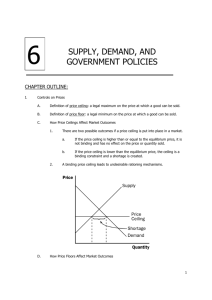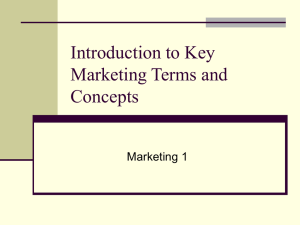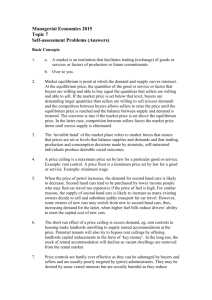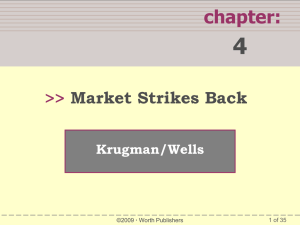Price and Quantity Controls
advertisement
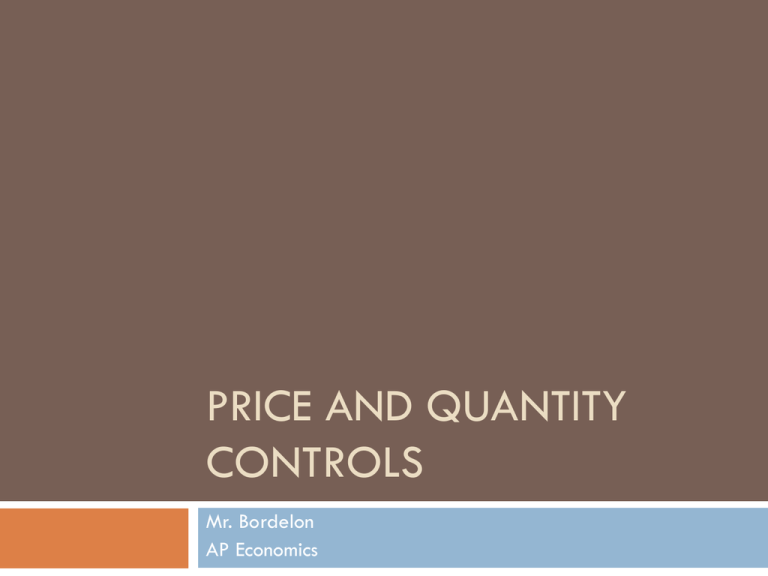
PRICE AND QUANTITY CONTROLS Mr. Bordelon AP Economics Price Controls Price control. A legal restriction on how high or low a market price may go. Price controls are enacted by governments in response to political pressures from buyers and sellers. Price Ceiling Price Ceilings Price Ceiling. Maximum price sellers are allowed to charge for a g/s. If PE is “too high” then a price ceiling (PC) must be set below PE. A PC set above PE has no effect. Effects of a Price Ceiling Shortage. QD – QS In theory, consumers are helped by the lower price. In practice, only those who got the g/s are helped. Price ceilings ALWAYS cause shortages. Inefficient Allocation to Consumers. With a price ceiling, people who want the good and are willing to pay a higher price don’t get it. Those who care less about the good, and are only willing to pay a low price do get it. Luck of the draw. Effects of a Price Ceiling Wasted Resources. People spend money, time and effort in order to deal with shortages caused by the price ceiling. Time spent has an opportunity cost. Time spent looking for g/s has an opportunity cost—working, playing, studying, etc. This creates inefficiency to the price control. Inefficient low quality. With a PC, sellers will offer low-quality goods, though buyers prefer higher quality, even at a higher price. No incentive for sellers to provide higher quality. Effects of a Price Ceiling Black Market. A market in which g/s are bought and sold illegally—either because it is illegal to sell them at all or because the prices charged are legally prohibited by a price ceiling. Why Have Price Ceilings At All? They do benefit some consumers. Consumers may have political clout to persuade government that PE is taking advantage of them. Long term. If a PC is in effect for a while, buyers may not have a realistic idea of what would happen without them. Politicians are idiots. Government officials often do not understand supply and demand analysis. Price Floor Price Floors Price Floor. A legal minimum price buyers are required to pay for a good. Minimum Wage. A legal floor on the wage rate, which is the market price of labor. If PE is considered “too low,” a price floor (PF) is set above PE. A PF set below PE has no effect. Effects of a Price Floor Surplus. PF lead to excess supply. QS – QD In theory, sellers helped by the higher price. In practice, sellers now have extra g/s, because there are less people willing to buy g/s at PF. Price floors ALWAYS cause surpluses. Inefficient allocation of sales among sellers. Those who would be willing to sell the good at the lowest price are not always those who actually manage to sell it. Effects of a Price Floor Wasted resources. Government price floors set above PE causes surpluses which the government may be required to buy and destroy. Minimum wages result in fewer jobs available and those who’d be willing to work for less waste time searching for a job. Inefficiently low quantity. Since a PF raises the price of a good to consumers, QD falls, so the quantity bought and sold falls, creating a loss to society. Effects of a Price Floor Goods of inefficiently high quality. Sellers offer high-quality goods at a high price, even though buyers would prefer a lower quality at a lower price. Illegal activity. Price floors encourage bribery of sellers or government officials. Minimum wage laws give an incentive to work under the table because there is a surplus of labor willing to work. Why Have Prices Floors At All? They do benefit some producers. Producers may have political clout to persuade government that PE is unfairly low. Politicians are idiots. Government officials often do not understand supply and demand analysis. Quantity Controls Quantity control/quota. Upper limit on the quantity of some good that can be bought or sold. Quotas are set by government. License. Gives its owner the right to supply a g/s. Anatomy of Quantity Controls PD: Demand price is price at which consumers will demand that quantity. PS: Supply price is price at which producers will supply that quantity. Quantity control drives a wedge between PD and PS of a good. Quota rent is the difference between PD and PS. Earnings that accrue to license-holder from ownership of right to sell good. It is equal to the market price of the license when licenses are traded. Costs of Quantity Controls Inefficiency. Mutually beneficial transactions don’t occur. Anytime PD at any given quantity is not equal to PS at that quantity, there will be missed opportunities. Deadweight loss. Lost gains associated with transactions that do not occur due to market intervention. Incentives for illegal activities. Suppliers know additional units could be supplied and buyers could be found. This overproduction violates the quota.




